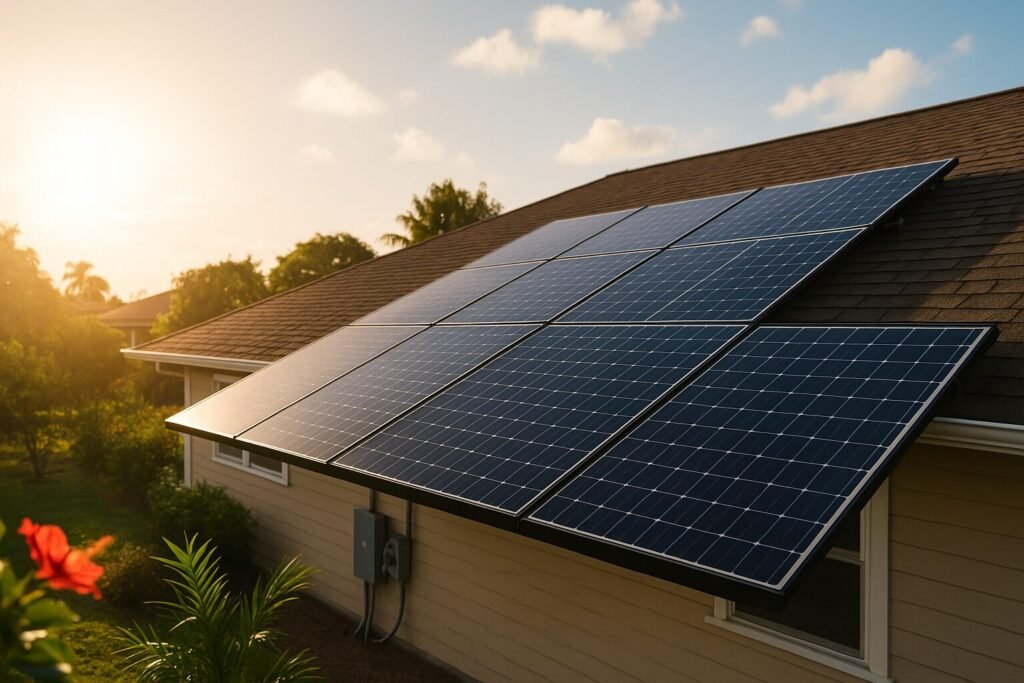Basics of Solar Energy: Simple Guide to Solar Efficiency
Learn the basics of solar energy—PV explained, key components, solar efficiency tips, batteries, and system types—to size a system and lower bills.
Why I Finally Went Solar
I still remember the first day my monitoring app showed more green bars than gray. It felt like I’d unlocked a cheat code. Before that, I was overwhelmed by acronyms, diagrams, and opinions. If you’re there right now—confused but curious—this post is for you. I’ll keep it simple, practical, and honest. I’ll share what I learned, the shortcuts I wish I’d known, and a few mistakes I made so you don’t have to repeat them.
What Is Solar Energy—and How the PV Effect Makes Electricity
Sunlight, photons, and semiconductors (plain-English).
Sunlight is a stream of tiny energy packets called photons. Solar cells are slices of semiconductor (usually silicon) designed so incoming photons knock electrons loose. That movement creates an electric current. That basic interaction is the photovoltaic (PV) effect.
From DC to usable power—where the inverter fits.
Panels produce DC electricity. Your home and the grid use AC. The inverter converts DC to AC, synchronizes with the grid, and keeps everything safe and useful. Think of panels as the muscles and the inverter as the translator.
My quick analogy.
Imagine a row of dominoes (electrons). Sunlight taps the first domino. Panels guide the fall so the motion becomes a steady flow of electricity. The inverter takes that orderly motion and turns it into the kind your home can use.
The Main Parts of a Home Solar System
Solar panels (modules).
A panel is a frame, glass, a backsheet, and cells wired into strings. Panels are grouped to reach your target system size (e.g., 4–10 kW for many homes).
Inverters.
- String inverters: one unit for many panels.
- Microinverters: one per panel for panel-level optimization.
- Hybrid inverters: can manage both solar and batteries.
Racking & attachments.
Racking secures panels to the roof or ground. Pay attention to waterproofing on roof penetrations and corrosion-resistant hardware.
Wiring, safety gear, and monitoring.
You’ll see combiner boxes, disconnects, grounding, and a production meter. Monitoring lets you see daily, monthly, and lifetime solar generation.
Alternatives to roof mounts.
If the roof is shaded or awkward, consider a ground mount or solar carport. They allow perfect tilt and orientation and are easy to clean.
PV vs. Solar Thermal—Don’t Mix These Up
PV = electricity.
Solar thermal = heat (typically for water or space heating). PV is the standard for home electricity generation. Solar thermal can still make sense if you use a lot of hot water and have good sun exposure.
What I chose and why.
I went PV because I wanted to offset my electric bill and support future electric loads (EV charging, heat pump). If you’re mostly chasing hot water savings, solar thermal is worth a look; otherwise, PV is the flexible workhorse.
Do Panels Work on Cloudy Days, in Shade, or at Night?
Clouds.
Yes, panels still produce power under diffuse light, just less. Expect lower output on overcast days.
Shade.
Shade reduces production. Bypass diodes and panel-level electronics help, but they can’t create sunlight. If shade is unavoidable, microinverters or optimizers can protect your overall system performance.
Night.
No sunlight means no generation. At night, you draw from the grid or from batteries if you have them.
How Much Power Can a Panel or Home System Produce?
Watts vs. watt-hours vs. kilowatt-hours.
- Watt (W) or kilowatt (kW): power/size of the system.
- Kilowatt-hour (kWh): energy over time (what your utility bills you for).
Back-of-envelope math.
Daily kWh ≈ system kW × average sun-hours (plus losses). If you have a 6 kW system and average 5 sun-hours/day: 6 × 5 = ~30 kWh/day before losses. Real-world numbers vary with weather, temperature, shading, and hardware.
What a typical array covers.
A 4–8 kW system can cover a good portion of a typical home’s electricity, depending on usage and sun. Pull your last 12 months of bills to know your actual kWh.
What “Efficiency” Really Means (and Why Roof Space Matters)
Panel efficiency.
Efficiency is how much sunlight a panel turns into electricity per area. Higher efficiency = more watts from the same roof space.
System efficiency.
Inverters, wiring, temperature, and dirt reduce output. Brochure numbers assume great conditions; real life is messier.
When higher efficiency pays off.
If you have limited roof area, aim for higher-efficiency panels. If roof space is abundant, you can often achieve the same annual kWh with more standard panels.
Site Factors That Make or Break Performance
Orientation and tilt.
South-facing (in the northern hemisphere) with a moderate tilt is ideal, but east/west can still work well, especially for morning/evening loads.
Shade mapping.
Check for year-round shade from trees, chimneys, and neighboring buildings. Shade often changes with seasons and tree growth.
Temperature effects.
Panels don’t love heat. Hot roofs reduce voltage and output. A bit of airflow under panels helps.
Roof condition.
If the roof needs work, handle it before installing. You’ll save time and avoid future rework.
Do Panels Store Energy? (No—But Batteries Do)
Panels generate. Batteries store. Inverters coordinate.
Panels send power to the inverter. The inverter powers your home, charges the battery (if installed), and exports excess to the grid.
Battery basics.
- Capacity (kWh): how much energy it can store.
- Power (kW): how fast it can deliver energy.
- Depth of Discharge (DoD): how much of the battery you can use.
When I recommend storage.
If you experience outages, want backup for essentials, or want to shift solar to the evening peak, batteries are great. If your grid is stable and you’re primarily chasing bill savings, you might wait.
Grid-Tied, Off-Grid, and Hybrid—Which Fits Your Life?
Grid-tied.
Your system connects to the grid. You use solar when available and export excess. Simple, cost-effective, and common.
Off-grid.
You’re fully independent. You’ll need a larger battery capacity and a generator plan for long cloudy stretches. Freedom with tradeoffs.
Hybrid.
Grid-tied with batteries. You get backup power plus the ability to shift solar to evenings. A nice balance if resilience matters.
Lifespan, Reliability, and Maintenance
Panels.
Panels often carry 20–25+ year performance warranties and can last longer. Expect a slow decline in output over time.
Inverters.
Inverters do the heavy lifting and may need replacement once or twice over a system’s life, depending on the type and environment.
Maintenance, I actually do.
- Visual check of racking and wiring.
- Clean panels only if grime or bird droppings are obvious.
- Review the monitoring app monthly for odd dips or inverter alerts.
- After storms, I look for debris and shading changes.
Costs, Incentives, and Payback Basics
What drives cost?
Equipment (panels, inverter, batteries), labor, racking, permits, and any roof or electrical upgrades.
Incentives to research.
Look into federal tax credits, local rebates, and net metering or similar programs. These can improve the project’s math and shorten payback time.
Payback vs. peace of mind.
Payback is one lens. Also consider bill stability, resilience during outages, and long-term energy independence. I like to model simple payback, then look at cash flow and “sleep-at-night” benefits.

Step-By-Step Mini-Guide—From Idea to Switch-On
- Check the roof and the sun.
Look for good exposure, minimal shade, and solid roofing. Note obstacles (vents, skylights). - Pull 12 months of bills.
Track kWh, not just dollars. Your usage pattern is your sizing roadmap. - Define your goal.
Bill savings? Backup power? Both? Your goal affects inverter and battery choices. - Rough-size the system.
Use: Target daily kWh ÷ sun-hours ≈ needed kW. Example: 24 kWh/day ÷ 5 sun-hours ≈ 4.8 kW. - Pick an approach.
Grid-tied for simplicity, hybrid for resilience, off-grid for independence. - Plan permits and interconnection.
Your utility and local jurisdiction will have steps. Expect inspections and an official permission-to-operate. - Install, inspect, monitor.
Once live, watch your monitoring app for the first month. You’ll learn your peak production times and where small tweaks help.
Common Pitfalls I See (And How to Dodge Them)
- Oversizing without checking the main panel.
Your electrical service may need an upgrade or a busbar calculation. - Ignoring seasonal shade.
Trees grow. The winter sun path is lower. Use shade analysis, not just a quick glance in July. - Skipping roof work.
If the roof is near end-of-life, handle it first. It’s cheaper and cleaner than doing it later. - Forgetting future loads.
Planning to add an EV, heat pump, or workshop? Consider it now so you’re not boxed in later.
Quick Glossary (Bookmark-Worthy)
Photovoltaic (PV): Turning light into electricity.
kW vs. kWh: kW is system size (power); kWh is energy used over time.
Sun-hours: Average daily sunlight useful for solar (varies by location).
Microinverter: A Small inverter attached to each panel.
Optimizer: Panel-level device that improves performance with a central inverter.
DC-coupled / AC-coupled: Battery integration architectures.
Depth of Discharge (DoD): How much of a battery’s stored energy you can use.
Net metering: Credit for excess solar you send to the grid.
Interconnection: Utility approval to operate your system.
Conclusion: My Takeaways After Living With Solar
If I could go back, I’d do three things sooner:
- Audit my usage so system sizing matches my real life.
- Plan for future loads so expansion wouldn’t be painful.
- Pick a clean layout with minimal shade and easy maintenance.
Solar isn’t just about lower bills. It’s about control, resilience, and using clean energy every single day. Start with your roof, your bills, and your goals—and build from there.
